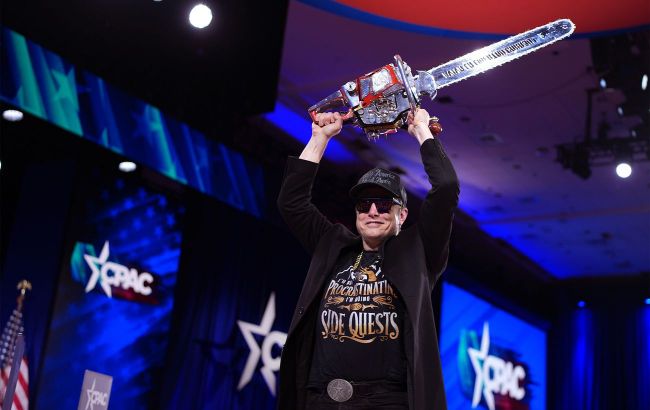Third force: Why US has only two parties and how Elon Musk plans to break system
 Elon Musk (photo: Getty Images)
Elon Musk (photo: Getty Images)
Elon Musk announced his intention to eliminate the two-party monopoly of the Democrats and Republicans on power in the USA.
Why there is demand for this in the States and whether the billionaire's plans are realistic – read in the RBC-Ukraine article.
Key questions:
- Why did Elon Musk decide to challenge the US political system?
- Why do only two parties dominate in the States?
- Why do new political forces not succeed at the national level?
- What could change this situation?
On June 7, Elon Musk stated that a new political party should be created in the USA, "which will represent 80% of the middle class." This statement appeared after his public quarrel with US President Donald Trump and caused a real stir in the States. Musk conducted a poll on his page in X, after which he actually announced the creation of a new political force – the America Party.
A challenge to the two-party system is coming from another side as well. In New York, in the Democratic Party primary election for the position of city mayor, Zohran Mamdani, a left-wing politician of Ugandan-Indian origin and a member of the Democratic Socialists of America party allied with the Democrats, won.
These are only the latest, but far from the only, indications that there is strong demand in American society for a new political force.
In the USA, for many years two major parties have dominated – the Democratic and the Republican. Only they nominate presidents and the absolute majority of members of Congress. For many Americans, this does not look like full freedom of choice, but rather the possibility of choosing "the lesser evil." This was especially true last year when elderly and controversial Donald Trump and Joe Biden, who was later replaced by the controversial Kamala Harris, were competing for the presidency.
According to a Gallup poll in October of last year, 58% of Americans believed that a third political party was needed because the Republican and Democratic parties poorly represent the interests of the people. This is slightly less than the record 63% in 2023, but still reflects significant dissatisfaction with the two-party system. 69% of independent voters, 53% of Democrats, and 48% of Republicans support the idea of a third party.
According to Pew Research Center, this support is especially high among younger voters: 48% of those under 30, and 46% among respondents aged 30–49.
Why are there only two parties in USA
Formally, there are many nationwide registered parties in the USA. The most notable among them are the Constitution Party, the Green Party, and the Libertarian Party. However, most of them have little influence on the political situation.
Elections in the USA are usually held under a majoritarian voting system – both at the state level and nationwide. In such a system, the principle of "winner takes all" operates - the candidate who wins in their district gets the seat in Congress, regardless of how narrow, even by a single vote, their advantage was.
This encourages the concentration of votes around the two main parties, as voting for a candidate from smaller parties is often perceived as a "wasted vote."
In addition, in many states, there are complicated rules for access to elections for new parties. For example, candidates from a third party often have to collect thousands of signatures, which requires significant resources. The two main parties have an established infrastructure for this and easily meet this requirement, while small parties may not have the resources to do so.
Furthermore, financial resources are important. Election campaigns in the USA are expensive, and large donors usually support only candidates from the two main parties, who have real chances of winning. The media also usually pay less attention to candidates from third parties, reducing their visibility.
Nevertheless, from time to time individual representatives of third parties win seats thanks to their charisma. Especially at the local level – in the legislatures of individual states. However, in such cases, it is more about individual politicians than systematic party work.
Can something change – successful examples
The role of parties increases at higher levels – starting with elections for state governor. Due to the larger scale, a small team of like-minded people is no longer sufficient, and at least some network of campaigners is needed.
In modern US history, there have been several cases when a third party achieved success at the level of a particular state.
In 1998, wrestler and actor Jesse Ventura became governor of Minnesota from the Reform Party, receiving 37% of the vote. Among other factors, his victory was facilitated by his charisma, media popularity, and voters' disappointment in the two-party system.
In the state of Connecticut in the 1990 election, Lowell Weicker became governor from the Connecticut Party, gaining support due to his moderate stance and criticism of the two main parties.
That same year, Alaska was headed by Walter Hickel, elected governor from the Alaskan Independence Party, which advocated for greater autonomy for the state.
At the nationwide level, the only successful example is Theodore Roosevelt's campaign from the Progressive Party in 1912. In the presidential election, he received 27.4% of the popular vote and 88 votes in the Electoral College, taking second place. This is the only case when a third-party candidate outperformed one of the main party candidates – Republican William Taft.
However, Roosevelt relied on a personal brand that had already been built. Before that, he had twice been President. And the Progressive Party arose as a result of a split from the Republican Party, so the entire party infrastructure at the local level was also ready. However, after losing the election, the party disappeared as quickly as it appeared.
All these examples show that it is theoretically possible to form a third party in the USA, but this requires money for the campaign, a powerful personal brand of its leader, as well as support from part of the elites in Washington and most states.
The last point is especially important, and the hardest to achieve - those who would go against the Democrats and Republicans must be ready for losses: from disrupted government contracts and economic damage to attacks on personal reputation. By the way, during the quarrel with Musk, Trump already hinted at checking Musk's contracts with government agencies, and even at the billionaire's deportation from the USA.
So for most local elites, it is easier to negotiate an alliance with the Democrats or Republicans. However, the situation may change. After all, in Trump-era America, many things are happening for the first time in history.
Earlier, RBC-Ukraine reported how Elon Musk became Donald Trump's favorite, what results their cooperation produced, and why the billionaire fell into disgrace.
Sources: data from Gallup and Pew Research surveys, publications of The New York Post, Politico, NPR, and The Atlantic were used.

